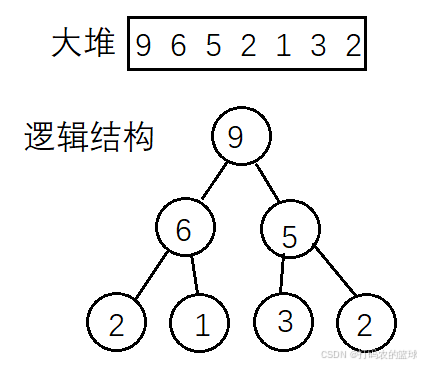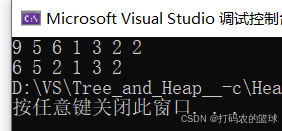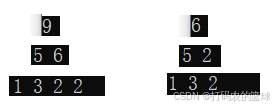heap.h------标准库包含、函数声明
heap.c------函数定义
main.c------测试
堆的逻辑结构是一颗完全二叉树:

heap.h
heap.h中应包含如下定义和功能:
cpp
#pragma once
#include<stdio.h>
#include<stdbool.h>
#include<assert.h>
#include<stdlib.h>
typedef int HPDataType;
typedef struct Heap
{
HPDataType* a;
int size;
int capacity;
}Heap;
// 堆初始化
void HeapInit(Heap* php);
// 堆的销毁
void HeapDestory(Heap* hp);
//向上调整
void AdjustUp(HPDataType* a, int child);
// 堆的插入
void HeapPush(Heap* hp, HPDataType x);
//向下调整
void AdjustDown(HPDataType* a, int n, int parent);
// 堆的删除(删除堆顶元素)
void HeapPop(Heap* hp);
// 取堆顶的数据
HPDataType HeapTop(Heap* hp);
// 堆的数据个数
int HeapSize(Heap* hp);
// 堆的判空
bool HeapEmpty(Heap* hp);heap.c
逐个在 heap.c 中实现上述功能,同时保证代码的健壮性:
在 heap.c 中包含 heap.h
1、堆初始化
cpp
// 堆初始化
void HeapInit(Heap* php) {
assert(php);
php->a = NULL;
php->capacity = 0;
php->size = 0;
}2、堆的销毁
cpp
// 堆的销毁
void HeapDestory(Heap* hp) {
assert(hp);
free(hp->a);
}3、向上调整
cpp
//交换元素
void Swap(HPDataType* p1, HPDataType* p2) {
HPDataType tmp = *p1;
*p1 = *p2;
*p2 = tmp;
}
//向上调整
void AdjustUp(HPDataType* a, int child) {
int parent = (child - 1) / 2;
//只要 child 有效,都会进入循环判断
while (child > 0) {
//建立大堆
if (a[child] > a[parent]) {
Swap(&a[child], &a[parent]);
child = parent;
parent = (child - 1) / 2;
}
else { //已满足堆的条件
break;
}
}
}4、堆的插入
cpp
// 堆的插入
void HeapPush(Heap* hp, HPDataType x) {
assert(hp);
//检查容量,如果已满,扩容
if (hp->size == hp->capacity) {
int newCapacity = hp->capacity == 0 ? 4 : hp->capacity * 2;
HPDataType* tmp = (HPDataType*)realloc(hp->a, sizeof(HPDataType) * newCapacity);
if (tmp == NULL) {
perror("realloc failed");
return;
}
hp->a = tmp;
hp->capacity = newCapacity;
}
hp->a[hp->size++] = x;
//尾插新数据后,向上调整
//传入数组和孩子下标
AdjustUp(hp->a, hp->size - 1);
}5、向下调整
cpp
//向下调整
void AdjustDown(HPDataType* a, int n, int parent) {
int child = parent * 2 + 1; //左孩子
//调整时,parent 要与 左右孩子中大的那个交换--
//--以保证满足大堆条件
while (child < n) {
//选出左右孩子中较大者
if ((child + 1) < n && a[child] < a[child + 1]) {
child++;
}
if (a[parent] < a[child]) {
Swap(&a[parent], &a[child]);
parent = child;
child = parent * 2 + 1;
}
else { //已满足大堆条件
break;
}
}
}6、堆的删除
cpp
// 堆的删除(删除堆顶元素)
void HeapPop(Heap* hp) {
//交换堆顶和堆底元素,删除堆底元素,向下调整
assert(hp);
assert(!HeapEmpty(hp)); //堆不能为空
Swap(&hp->a[0], &hp->a[hp->size - 1]);
hp->size--;
AdjustDown(hp->a, hp->size, 0);
}7、取堆顶元素
cpp
// 取堆顶的数据
HPDataType HeapTop(Heap* hp) {
assert(hp);
assert(!HeapEmpty(hp)); //堆不能为空
return hp->a[0];
}8、堆的数据个数
cpp
// 堆的数据个数
int HeapSize(Heap* hp) {
assert(hp);
return hp->size;
}9、判断堆空
cpp
// 堆的判空
bool HeapEmpty(Heap* hp) {
assert(hp);
return hp->size == 0;
}main.c
cpp
#include"heap.h"
void Test1() {
Heap hp;
HeapInit(&hp);
HeapPush(&hp, 2);
HeapPush(&hp, 1);
HeapPush(&hp, 3);
HeapPush(&hp, 6);
HeapPush(&hp, 5);
HeapPush(&hp, 9);
HeapPush(&hp, 2);
for (int i = 0; i < hp.size; i++) {
printf("%d ", hp.a[i]);
}
printf("\n");
HeapPop(&hp);
for (int i = 0; i < hp.size; i++) {
printf("%d ", hp.a[i]);
}
HeapDestory(&hp);
}
int main() {
Test1();
return 0;
}
将存储的数据拆成完全二叉树后,仍然是大堆,没有问题
